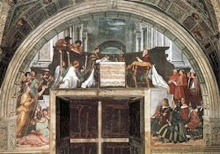

Pietro Antonio and Giovanna Monaldeschi
The marriage in 1480 of Pietro Antonio Monaldeschi della Vipera della Sala and his cousin, Giovanna Monaldeschi della Cervara ended the internecine strife between the Monaldeschi factions.
One of the frescoes in the vaults of the Cappella Nuova contains two sets of Monaldeschi arms, which probably reflect the bequest of 100 florins mandated by Pietro Antonio Monaldeschi in his will of 1488. As his widow, Giovanna transferred this sum to the Opera del Duomo in 1500, and it helped to finance the associated payment to Luca Signorelli.

A memorial tablet to the right of the entrance wall to the Cappella Nuova seems to have belonged to a monument that Giovanna erected for her husband in 1516. The encomium translates: “His father having been exiled by tyranny, he [i.e. Pietro Antonio] nevertheless conducted himself with equanimity and care for the republic ... with such integrity and faith that no one surpassed him in public charity”.
Giovanna made a payment towards the construction of the nearby Altare dei Magi, in 1509. When she died in 1518, she bequeathed Castello della Sala to the Opera del Duomo.
Antonio degli Albèri
Antonio degli Albèri, who held the post of Archdeacon of the Duomo in the period 1497-1503, probably advised on the content of the frescoes in the Cappella Nuova. He had also built the adjacent library in ca. 1500, probably in emulation of the Piccolomini Library in the Duomo of Siena, which had been built in 1492-1502 by his friend, Cardinal Francesco Todeschini Piccolomini.
Cardinal Piccolomini, who was elected as Pope Pius III in 1503, appointed Antonio degli Albèri as Bishop of Sutri and Nepi. Pius III died shortly afterwards, and Antonio degli Albèri followed him to the grave in 1506.
Julius II (1503-13)

Fresco (1508-13) by Raphael:
Pope Julius II meditates on the miracle of Bolsena
Stanza di Eliodoro, Vatican Palace
[Pope Julius II visited Orvieto and prayed over the Sacro Corporale in 1506.]
Clement VII (1523-34)
Cardinal Nicolo Ridolfi administered the diocese in the period 1520-9.
Pope Clement VII became interested in Orvieto as political tensions in Italy rose, particularly after he was forced to pay off the Colonna family after its successful attack on Rome (September 1526). He ordered the Conservatori della Pace to fortify and provision the city, and he sent Antonio da Sangallo the Younger to draw up plans for the fortifications. The subsequent work included the fortification of Porta Maggiore. Antonio da Sangallo was given citizenship in March 1527.
When Rome was sacked in May 1527 and Clement VII took refuge in the Castel Sant’ Angelo, Francesco della Rovere assembled the papal forces in Orvieto. In October, the Conservatori della Pace wrote to Bishop [ ] declaring the loyalty of the people to the papal cause and their willingness to provide a refuge for him. Clement VII negotiated with his Imperial captors from a very weak position, but he was able to insist that, in return for the huge payment demanded and the release of a number of prominent hostages, he should be allowed to take refuge in Orvieto. Preparations to receive him were in train by November. and he duly arrived on 8th December with four cardinals. In a consistory held in Palazzo Papali on 18th December, Clement VII repudiated all of the concessions that he had been forced to grant while a prisoner in the Castel Sant’ Angelo.
One of the problems that the papal refugees faced was the lack of water, since the medieval aqueduct was in a ruinous state and was vulnerable should the city suffer a siege. He immediately ordered the construction of four cisterns in Piazza del Duomo and of another, deeper one near the fountain in Via della Cava. He also commissioned Antonio da Sangallo to prospect for a source of water closer to the Rocca, a project that led to the construction of the Pozzo di San Patrizio. (The excavations were finished early in 1532).
Clement VII and his court were penniless and this led to heavy exactions on the people of Orvieto and the surrounding area. When Bishops Fox and Gardner arrived in March to negotiate on behalf of King Henry VIII of England to negotiate the annulment of his marriage to Queen Katherine, they reported (inter alia) that Clement VII was lodged "in an old palace of the bishops of this city, ruinous and decayed".
The papal court attracted many people to the city, which led to serious food shortages. Disease was rife and brigands menaced the surrounding roads. By April, plans were afoot for the papal court to move to Viterbo. Clement VII duly left for Viterbo on 1st June and was finally able to move on to Rome in October. As a consequence of his few months in Orvieto, the city began its revival.
Paul III (1534-49)
[Text]
Girolamo Simoncelli and Sebastiano Vanzi (1554-1605)
Cardinal Bishop Girolamo Simoncelli, great nephew of Pope Julius III, was bishop of Orvieto in the period 1554-62. He lived in the diocese (his native city) and was noted for his pastoral care. He resigned in 1562 in favour of Sebastiano Vanzi (1562-71), who distinguished himself at the Council of Trent. Bishop Vanzi built the seminary, but it foundered two years after his death in 1571. Cardinal Bishop Girolamo Simoncelli returned to administer the diocese from this point until his death in 1605.

